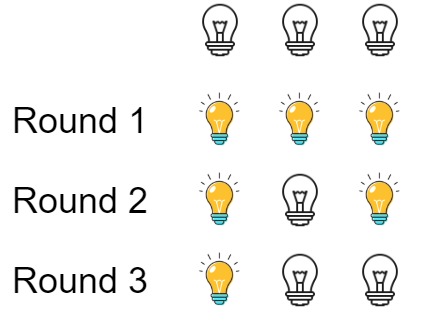319.Bulb Switcher
===
###### tags: `Medium`,`Math`
[319. Bulb Switcher](https://leetcode.com/problems/bulb-switcher/)
### 題目描述
There are `n` bulbs that are initially off. You first turn on all the bulbs, then you turn off every second bulb.
On the third round, you toggle every third bulb (turning on if it's off or turning off if it's on). For the i^th^ round, you toggle every `i` bulb. For the n^th^ round, you only toggle the last bulb.
Return *the number of bulbs that are on after* `n` *rounds.*
### 範例
**Example 1:**

```
Input: n = 3
Output: 1
Explanation: At first, the three bulbs are [off, off, off].
After the first round, the three bulbs are [on, on, on].
After the second round, the three bulbs are [on, off, on].
After the third round, the three bulbs are [on, off, off].
So you should return 1 because there is only one bulb is on.
```
**Example 2:**
```
Input: n = 0
Output: 0
```
**Example 3:**
```
Input: n = 1
Output: 1
```
**Constraints**:
* 0 <= `n` <= 10^9^
### 解答
#### C++
```cpp=
#include <iostream>
#include <cmath>
class Solution {
public:
int bulbSwitch(int n) {
int square_numbers_count = count_square_numbers(n);
return square_numbers_count;
}
public:
int count_square_numbers(int n) {
int count = 0;
for (int i = 1; i * i <= n; i++) {
count++;
}
return count;
}
};
```
> [name=順神][time=Apr 26, 2023]
#### Javascript
```javascript=
function bulbSwitch(n) {
return Math.floor(Math.sqrt(n));
}
```
> 寫完看到一堆一行超人,只能跟上了
> [name=Marsgoat][time=Apr 27, 2023]
#### C#
```C#=
public int BulbSwitch(int n) {
return (int)Math.Sqrt(n);
}
```
> [name=Jim][time=Apr 27, 2023]
#### Python
```python=
class Solution:
def bulbSwitch(self, n: int) -> int:
return int(sqrt(n))
```
> [name=Ron Chen][time=Thu, Apr 27, 2023]
### Reference
[回到題目列表](https://hackmd.io/@Marsgoat/leetcode_every_day)